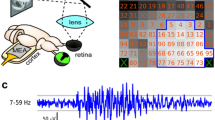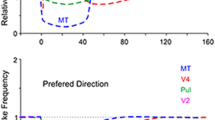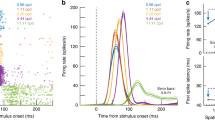Summary
The visual response properties of cells in the middle (MS) and lateral (LS) suprasylvian cortices were studied in alert cats, which were trained to fixate a spot of light and maintain fixation when a second test light was introduced in the midst of fixation. This second light served to test for visual sensitivity, and it could be moved at different speeds in any direction under computer control. Over half of the cells exhibited a visual response. With a small spot of light, most cells were directionally selective and responded better to a moving spot than to a stationary one. In some cases movements of the spot in the non-preferred direction revealed an inhibitory process. The visual receptive fields were large and often extended into the ipsilateral hemifield, though the centers of the receptive fields were usually in the contralateral field. We used Fourier analysis to quantify directional selectivity and compared these results to other commonly used measures of directional selectivity. Compared to cells in MS, there was a higher incidence of visual cells in LS and the visual cells were more directional. We also made comparisons between our results and those found in anesthetized cats and awake monkeys.
Similar content being viewed by others
References
Albright TD (1984) Direction and orientation selectivity of neurons in visual area MT of the macaque. J Neurophysiol 52:1106–1130
Baker JF, Petersen SE, Newsome WT, Allman JM (1981) Visual response properties of neurons in four extrastriate visual areas of the Owl Monkey (Aotus Trivirgatus): a quantitative comparison of medial, dorsomedial, dorsolateral and middle temporal areas. J Neurophysiol 45:397–416
Barlow HB, Levick WR (1965) The mechanism of directionally selective units in rabbit's retina. J Physiol (Lond) 178:477–504
Berson DM (1985) Cat lateral suprasylvian cortex: Y-cell inputs and corticotectal projection. J Neurophysiol 53:544–556
Berson DM, Graybiel AM (1978) Parallel thalamic zones in the LP-pulvinar complex of the cat identified by their afferent and efferent connections. Brain Res 147:139–148
Berson DM, Graybiel AM (1983) Organization of the striate-recipient zone of the cat's lateralis posterior-pulvinar complex and its relations with the geniculostriate system. Neuroscience 9:337–372
Blakemore CB, Zumbroich TJ (1987) Stimulus selectivity and functional organization in the lateral suprasylvian visual cortex of the cat. J Physiol (London) 389:569–603
Camarda R, Rizzolatti G (1976) Visual receptive fields in the lateral suprasylvian area (Clare-Bishop area) of the cat. Brain Res 101:427–443
Clare MH, Bishop GH (1954) Responses from an association area secondarily activated from optic cortex. J Neurophysiol 17:271–277
Cremieux J, Orban GA, Duysens J (1984) Response of cat visual cortical cells to continuously and stroboscopically illuminated moving slits compared. Vision Res 178:449–457
Dow BM, Dubner R (1969) Visual receptive fields and responses to movement in an association area of cat cerebral cortex. J Neurophysiol 32:773–784
Felleman DJ, Kaas JH (1984) Receptive-field properties of neurons in middle temporal visual area (MT) of owl monkeys. J Neurophysiol 52:488–513
Garey LJ, Jones EG, Powell TPS (1968) Interrelationship of striate and extra-striate cortex with the primary relay sites of the visual pathway. J Neurol Neurosurg Psychiat 31:135–157
Goldberg JM, Brown PB (1969) Response of binaural neurons of dog superior olivary complex to dichotic tonal stimuli: some physiological mechanisms of sound localization. J Neurophysiol 32:613–636
Graybiel AM (1974) Studies on the anatomical organization of posterior association cortex. In: Schmitt FO, Worden FG (eds) The neurosciences. Third Study Program M.I.T. Press, Cambridge, MA, pp 205–214
Graybiel AM, Berson DM (1980) Histochemical identification and afferent connections of subdivisions in the lateralis posteriorpulvinar complex and related thalamic nuclei in the cat. Neuroscience 5:1175–1238
Hardy SC, Stein BE (1988) Small lateral suprasylvian cortex lesions produce visual neglect and decreased visual activity in the superior colliculus. J Comp Neurol 273:527–542
Harutiunian-Kozak BA, Djavadian RL, Melkumian AV (1984) Responses of neurons in cat's lateral suprasylvian area to moving light and dark stimuli. Vision Res 24:189–195
Heath CJ, Jones EG (1971) The anatomical organization of the suprasylvian gyrus of the cat. Ergeb Anat Entwicklungsgesch 45:1–64
Herdman SJ, Tusa RJ, Smith CB (1989) Cortical areas involved in horizontal OKN in cats: metabolic activity. J Neurosci 9:1150–1162
Hubel DH, Wiesel TN (1969) Visual area of the lateral suprasylvian gyrus (Clare-Bishop area) of the cat. J Physiol (Lond) 202:251–260
Hyvärinen J (1982) The parietal cortex of monkey and man. Springer, Berlin Heidelberg New York
Joseph JP, Giroud P (1986) Visuomotor properties of neurons of the anterior suprasylvian gyrus in the awake cat. Exp Brain Res 62:355–362
Kawamura K (1973) Corticocortical fiber connections of the cat cerebrum. II. The parietal region. Brain Res 51:23–40
Kawamura S, Sprague JM, Niimi K (1974) Corticofugal projections from the visual cortices to the thalamus, pretectum and superior colliculus in the cat. J Comp Neurol 158:339–362
Kiefer W, Kruger K, Strauss G, Berlucchi G (1989) Considerable deficits in the detection performance of the cat after lesion of the suprasylvian visual cortex. Exp Brain Res 75:208–212
Mardia KV (1972) Statistics of directional data. Academic, London
Marshall WH, Talbot SA, Ades HW (1943) Cortical response of the anesthetized cat to gross photic and electrical afferent stimulation. J Neurophysiol 6:1–14
Maunsell JHR, Newsome WT (1987) Visual processing in monkey extrastriate cortex. Ann Rev Neurosci 10:363–402
Maunsell JHR, Van Essen DC (1983) Functional properties of neurons in middle temporal visual area of the Macaque monkey I. Selectivity for stimulus direction, speed, and orientation. J Neurophysiol 49:1127–1147
McIlwain JT (1964) Receptive fields of optic tract axons and lateral geniculate cells: peripheral extent and barbiturate sensitivity. J Neurophysiol 27:1154–1173
Mikami A, Newsome WT, Wurtz RH (1986) Motion selectivity in macaque visual cortex. I. Mechanisms of direction and speed selectivity in extrastriate area MT. J Neurophysiol 55:1308–1327
Montero VM (1981) Comparative studies on the visual cortex. In: Woolsey CN (ed) Cortical sensory organization: multiple visual areas. Humana Press, Clifton, N. J. pp 33–81
Mountcastle VB, Motter BC, Steinmetz MA, Duffy CJ (1984) Looking and seeing: the visual functions of the parietal lobe. In: Edelman GM, Gall WE, Cowan WM (eds) Dynamic aspects of neocortical function. Wiley, New York, pp 159–194
Noda H, Creutzfeldt OD, Freeman RB Jr (1971) Binocular interaction in the visual cortex of awake cats. Exp Brain Res 12:406–421
Olson CR, Lawler K (1987) Cortical and subcortical afferent connections of a posterior division of feline area 7 (area 7p). J Comp Neurol 259:13–30
Orban GA, Kennedy H, Maes H (1981) Response to movement of neurons in areas 17 and 18 of the cat: direction selectivity. J Neurophysiol 45:1059–1073
Palmer LA, Rosenquist AC, Tusa RJ (1978) The retinotopic organization of the lateral suprasylvian visual areas in the cat. J Comp Neurol 177:237–256
Pasternak T, Horn KM, Maunsell JHR (1989) Deficits in speed discrimination following lesions of the lateral suprasylvian cortex in the cat. Visual Neurosci 3:365–375
Raczkowski D, Rosenquist AC (1983) Connections of the multiple visual areas with the lateral posterior-pulvinar complex and adjacent nuclei in the cat. J Neurosci 3:1912–1942
Rauschecker JP, von Grünau MW, Poulin C (1987) Centrifugal organization of direction preferences in the cat's lateral suprasylvian visual cortex and its relation to flow field processing. J Neurosci 7:943–958
Rizzolatti G, Camarda R (1977) Influence of the presentation of remote visual stimuli on visual responses of cat area 17 and lateral suprasylvian area. Exp Brain Res 29:107–122
Robertson RT, Mayers KS, Teyler TJ, Bettinger LA, Birch H, Davis JL, Phillips DS, Thompson RF (1975) Unit activity in posterior association cortex of cat. J Neurophysiol 38:780–794
Rosenquist AC (1985) Connections of visual cortical areas in the cat. In: Peters A, Jones EG (eds) Cerbral cortex. Plenum, New York, pp 81–117
Sakata H, Shibutani H, Kawano K, Harrington TL (1985) Neural mechanisms of space vision in the parietal association cortex of the monkey. Vision Res 25:453–463
Sherk H (1986) Location and connections of visual cortical areas in the cat's suprasylvian sulcus. J Comp Neurol 247:1–31
Spear PD (1991) Functions of extrastriate visual cortex in nonprimate species. In: Leventhal A (ed) Vision and visual dysfunction, vol. 4, The neural basis of visual function. Macmillan Press, Basingstoke, England, pp 339–370
Spear PD, Baumann TP (1975) Receptive field characteristics of single neurons in lateral suprasylvian area of the cat. J Neurophysiol 38:1403–1420
Spear PD, Miller S, Ohman L (1983) Effects of lateral suprasylvian visual cortex lesions on visual localization, discrimination, and attention in cats. Behav Brain Res 10:339–359
Sprague JM, Levy J, DiBerardino H, Berlucchi G (1977) Visual cortical areas mediating form discrimination in the cat. J Comp Neurol 172:441–488
Steinmetz MA, Motter BC, Duffy CJ, Mountcastle VB (1987) Functional properties of parietal visual neurons: radial organization of directionalities within the visual field. J Neurosci 7:177–191
Straschill M, Schick F (1974) Neuronal activity during eye movements in a visual association area of cat cerebral cortex. Exp Brain Res 19:467–477
Symonds LL, Rosenquist AC (1984) Corticocortical connections among visual areas in the cat. J Comp Neurol 229:1–38
Tong L, Kalil RE, Spear PD (1982) Thalamic projections to visual areas of the middle suprasylvian sulcus in the cat. J Comp Neurol 212:103–117
Tusa RJ, Palmer LA, Rosenquist AC (1981) Multiple cortical visual areas: visual field topography in the cat. In: Woolsey CN (ed) Cortical sensory organization: multiple visual areas. Humana Press, Clifton, NJ, pp 1–32
Tusa RJ, Demer JL, Herdman SJ (1989) Cortical areas involved in OKN and VOR in cats: cortical lesions. J Neurosci 9:1163–1178
Van Essen DC (1985) Functional organization of primate visual cortex. In: Jones EG, Peters AA (eds) Cerebral cortex, Vol.3. Plenum Press, New York, pp 259–329
von Grünau M, Frost BJ (1983) Double-opponent-process mechanism underlying RF-structure of directionally specific cells of cat lateral suprasylvian visual area. Exp Brain Res 49:84–92
von Grünau MW, Zumbroich TJ, Poulin C (1987) Visual receptive field properties in the posterior suprasylvian cortex of the cat: a comparison between the areas PMLS and PLLS. Vision Res 27:343–356
Wörgötter F, Eysel UTh (1987) Quantitative determination of orientational and directional components in the response of visual cortical cells to moving stimuli. Biol Cybern 57:349–355
Yin TCT, Greenwood M (1992) Visuomotor interactions in responses of neurons in the middle and lateral suprasylvian cortices of the behaving cat. Exp Brain Res 88:15–32
Yin TCT, Medjbeur S (1988) Cortical association areas and visual attention. In: Steklis HD, Erwin J (eds) Comparative primate biology (Vol 4: Neurosciences) Liss, New York, pp 393–419
Zeki SM (1974) Functional organization of a visual area in the posterior bank of the superior temporal sulcus of the rhesus monkey. J Physiol (Lond) 236:549–573
Author information
Authors and Affiliations
Rights and permissions
About this article
Cite this article
Yin, T.C.T., Greenwood, M. Visual response properties of neurons in the middle and lateral suprasylvian cortices of the behaving cat. Exp Brain Res 88, 1–14 (1992). https://doi.org/10.1007/BF02259124
Received:
Accepted:
Issue Date:
DOI: https://doi.org/10.1007/BF02259124




